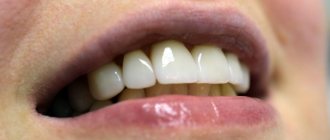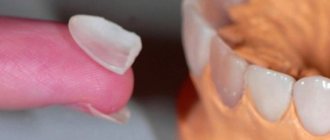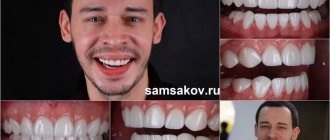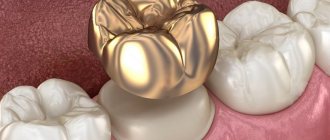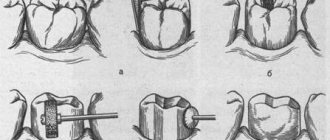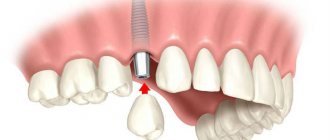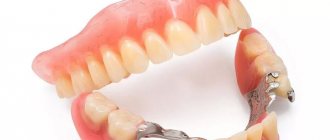A 25-year-old patient came to the clinic with a fairly popular, but, in her case, specific request to have a tooth extended. It was broken in childhood, but the patient found a broken piece, and kind dentists glued the piece back. According to the patient, he looked quite tolerable, although he was a little shorter than his neighbor, and he even tolerated orthodontic treatment well.
Treatment period is 3 weeks.
Price
| Feldspar veneer on a refractor | 45,000 rub. |
A patient came to the clinic with these teeth.
The reason for the patient’s visit to the clinic was that soon the composite material on which the previously chipped part of the tooth was glued became less aesthetically pleasing and stood out significantly in relation to the color of the dentition as a whole. This often happens with composite fillings, which are directly located in aesthetically important areas and often come into contact with coloring substances: coffee, tea, red wine, tomatoes. The difference in the length of the dentition has become more noticeable and noticeable over the years.
The picture shows a glued fragment of a broken tooth.
During the consultation survey, it was also found out that the adjacent central incisor also became darker than the lateral incisors for unknown reasons.
The patient was offered several alternative methods for restoring aesthetics, such as composite restoration and the popular, perhaps one of the most effective methods today - ceramic veneers on a refractor.
However, due to his young age and the presence of practically intact teeth (with the exception of a chipped tooth), it was decided to restore the shape and color of the two front teeth with ceramic veneers made of feldspathic ceramics, made on a refractory (fireproof) model.
Why are we the best in the ceramic veneers market?
- our doctors install more than a thousand veneers per year
- own dental laboratory
- we use only imported materials and medicines
- quality control at all stages of treatment
- absolute guarantee on design and work
- we offer veneers from economy class to premium highly artistic ones
- reviews from our patients are better than any words
- promotions and special offers allow you to save significantly
Call and make an appointment by phone 8-800-1000-234
Metal-free ceramics E-max
Metal-free ceramic crowns made using E-Max technology are one of the most advanced aesthetic ways to restore teeth in various clinical situations. The technology for manufacturing E-max ceramics was relatively recently developed by German scientists and has already deservedly enjoyed the trust of dentists and demand among patients all over the world. The material from which crowns are made contains less glass-like filler, and its lattice contains microscopic particles of leucite. It is the size of these particles that matters: the smaller the particles in the chemical lattice, the stronger the material.
E-Max ceramic crowns are not only durable (they demonstrate excellent functional qualities), but also very beautiful. Aesthetic inlays and veneers are also successfully produced using the E-max technology.
Advantages of E-Max metal-free ceramics:
- High aesthetics. The crown looks extremely beautiful even in comparison with other types of ceramic crowns. Moderate transparency and natural fit to the gum allow this technique to be used for making veneers.
- Biocompatibility with oral tissues. E-Max metal-free crowns are completely safe for allergy sufferers.
The disadvantage of E-max dental crowns is their high cost.
What is the difference between composite veneers and ceramic refractor veneers?
Ceramic veneers on a refractor occupy a special position in dentistry due to their unique properties. Only ceramics, unlike composite and glass ionomer materials, have the best aesthetic effect. Composite veneers, even of the highest quality, are essentially plastic. Composite is a material consisting of several components that shrinks and changes color over time. Due to the properties of ceramics and the varied palette of colors used in the process of creating veneers, it is possible to achieve ideal accuracy in conveying the color and shape of the tooth.
Only with the help of ceramic veneers on a refractor can you achieve a natural shade and natural light transmission. All-ceramic veneers do not lose their natural shine, they are strong and durable, do not stain over time and retain their original shape and texture.
Manufacturing stages
The key differences between refractory veneers and conventional ones lie in the method of creating the plates. The main task of dental technicians is to make a ceramic plate that would most accurately convey all the features of the tooth on which it will be fixed in order to obtain a tight fit. Without meeting these conditions, the veneer cannot be reliably and efficiently installed on the tooth.
When creating virirs with a refractor, everything happens a little differently, although the initial stages of forming microprostheses are similar:
- An orthopedic doctor photographs the patient’s teeth and takes an impression of them. This is necessary for 3D modeling of a future smile;
- diagnostic wax-up - creating wax models for veneers so that the patient can try them on and evaluate the result. Also, fittings and wax models are needed so that the doctor receives the most accurate picture of existing dental defects; this is important to consider when creating veneers;
- if necessary, preparation, or grinding, of teeth, during which the doctor removes a minimum layer of tooth enamel. However, in some cases, when creating veneers using a refractor, you can do without preparation;
- if the teeth still undergo grinding, the doctor installs temporary veneers on them to protect the teeth from external influences;
- creation of permanent veneers - the formation of a fire-resistant base, followed by layer-by-layer application of ceramic mass and baking in an oven;
- Before fixing to the teeth, the finished veneers are etched and washed with a special solution to achieve a strong connection with the front surface of the tooth;
- installation of permanent veneers using dental cement.
Installing veneers is a lengthy process that requires patience and several visits to the clinic. The production of plates alone in a dental laboratory takes from 1 to 3 weeks. Accordingly, the entire process from the first visit to an orthopedic dentist to the fixation of finished veneers can take about a month.
Can a ceramic veneer made with a refractor crack or break?
After manufacturing, ceramic veneers on the refractor are a thin plate. It looks like a translucent scale of a given color.
Of course, if the veneer is dropped or hit with a heavy object, it will crack and break. But, as soon as the doctor attaches this thin plate to the tooth with a special photopolymer composition, the veneer and tooth form a strong, monolithic connection. According to its technical characteristics, a ceramic veneer on a refractor is harder than tooth enamel. The use of veneers does not require any special conditions. The only restriction is not to test their strength and not to crack nuts with your teeth, not to chew through the wire and not to open bottles. Heavy loads can lead to chipping of your own tooth and detachment, compromising the integrity of the ceramic veneer.
Contraindications
Contraindications are the same as for conventional veneers:
- Bruxism – involuntary grinding of teeth during sleep;
- significant destruction of the crown of the tooth.
- significant bite defects;
- diseases of the teeth and gums (caries, pulpitis or periodontitis);
- tooth mobility;
Can teeth be treated after installing ceramic veneers?
Before installing ceramic veneers, the doctor must examine the patient’s oral cavity and carry out the necessary procedures: treats caries, removes plaque, whitens teeth. If caries subsequently occurs on the tooth with the veneer installed, treatment is carried out and a filling is installed. Also, after installing ceramic veneers, in order to extend the life of the plates, it is necessary to regularly carry out professional comprehensive cleaning of the oral cavity.
Empress metal-free ceramics
Empress ceramic technology is characterized by strength, durability and aesthetics.
Empress ceramics contain a large number of leucite crystals, which has a positive effect on its strength. The material from which it is made has similar properties to the enamel of natural teeth and has good color and light transmittance. This allows the orthodontist to very accurately select a color that matches the color of the teeth surrounding the crown.
As the name suggests, the crown is made by pressing. Using a cast plaster model that is an exact replica of the patient's teeth, the technician models the crown, reproduces it in wax, then places it in the porcelain casting system. A special ceramic mass is heated in a kiln and poured into a mold at high temperature and under pressure, while the wax is burned out. Afterwards, the almost finished crown is painted and covered with additional ceramics (or excess is removed), glazed and fired. The result is a custom-made crown with superior aesthetic and functional characteristics.
Advantages of Empress ceramics:
- Fully biocompatible material. No allergies;
- Naturalness. Complete imitation of the shape and color of teeth.
Empress is an earlier version of E-max technology and is gradually replacing one technology with another in the laboratory. E-max is a further development of Empress technology.
Metal-free ceramics on a zirconium dioxide framework
Although zirconium dioxide has become widely used in dentistry only recently and has already earned the trust of dentists and patients. Metal-free ceramic crowns and frameworks based on zirconium dioxide are gradually replacing metal-ceramic structures. High-tech ceramics have a number of positive qualities: mechanical properties similar to natural teeth, high precision fit, biological compatibility, aesthetic white color of the frame.
Zirconium dioxide does not adversely affect either the adjacent periodontal tissues or the body as a whole. It requires less preparation of the natural tooth crown for such ceramics than for other metal-free structures or metal ceramics. Since the strength of zirconium dioxide is very high, the thickness of the frame walls can be only 0.4 mm. Metal-free ceramics based on zirconium dioxide are the best option for restoring anterior teeth - it has the same degree of transparency as natural teeth and provides the most natural appearance, which is very important for anterior teeth.
Another advantage of this prosthetic technology is digital data processing and crown modeling in a 3D program. An impression of the patient's teeth is sent to a laboratory where models are cast, which are then scanned and digitized.
Using CAD/CAM technology, the tooth frame is modeled and milled automatically on a programmable machine. The zirconium blank, from which a special high-tech machine will mill the future frame, is matched to the color of the tooth. Only after this the technician begins artistic modeling of the tooth.
CAD/CAM technology allows you to manufacture the design of the future frame accurately and efficiently, which means it will last longer. Dentures made of metal-free ceramics for the front teeth always have good results and positive reviews.
One of the modern implementations of CAD/CAM technology using zirconium dioxide is CEREC , which allows you to make a ceramic prosthesis 2-3 hours after taking a digital impression of the tooth. This means that the patient no longer needs to come to the clinic several times. Came in in the morning without a tooth, left at lunchtime with a tooth. Read more about the technology here.

